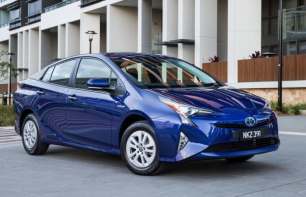If nothing else, all of the Prius’s edgy design gives it plentiful interior space. Toyota granted this generation of Prius a low seating position and tall roof, which combine with the distant dash elements to make for a spacious cockpit for the front two occupants.
The seat design in the top-spec I-Tech is also cushy, reminiscent of the seats in high-spec Camrys, and I had absolutely no trouble finding a comfortable driving position. If there’s one thing to be said for the annoying, centrally mounted instruments, it’s that you don’t need to consider the position of the wheel interfering with their visibility.
The Prius’s total glasshouse grants superb visibility out the front and sides, with large wing-mirrors, too. The only downside is that integrated spoiler at the back, which makes for a distracting view out the rear mirror that I’m sure any owner will quickly become accustomed to.
Soft trims across the doors and centre console, even in the back seat, make the Prius cabin a comfortable place to be, too.
Ergonomics have not been forgotten, with the multimedia screen and climate unit having useful and easy-to-reach physical dials and toggles for all the key functions. Even changing gear is a breeze in the Prius, with its odd little rosebud-shaped shifter simply a flick of the wrist from where your arm sits.
I do wish Toyota had made better use of the large area under the climate unit, however. The front part of the centre console is exclusively for the wireless-charging bay alone, and the rest of the space is constructed from a smoothly contoured gloss-finish plastic panel. It has looks to match the Prius aesthetic, but it’s no good for storing anything other than a single phone. It would have been better to make a large bay here with a rubberised finish.
Thanks to the lack of a physical handbrake in the centre or any other buttons or functions, there are two large bottle holders with variable edges.
A huge centre-console box and large door bins round out the Prius’s front-seat storage options.
Room in the rear seat is excellent, my 182cm tall frame had stellar amounts of space for my legs and head, as the roofline continues through to that raised rear spoiler. The comfy seat trim continues, although the padding in the base is notably not as good as it is in the front.
There are some useful pockets on the backs of the front seats and a drop-down armrest with cupholders for rear passengers, too.
Finally, the awkward rear of the Prius makes for a fantastic boot capacity, one advantage this car still holds over its hybrid Toyota stablemates. Capacity for the I-Tech is a mid-size-SUV rivalling 502-litres (VDA), which easily consumed our CarsGuide test luggage set and is even bigger than the base Prius, at the cost of the space-saver spare wheel. The I-Tech only has a repair kit to go with its larger alloys.

